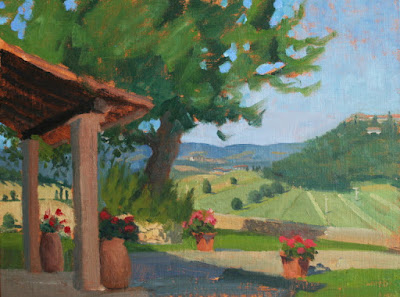
The Medici family put all the craftsmen and artisans who worked for the family in this former monastery and it continues to be the 'house of the goldsmith'. Casa dell' Orafo
On the first floor a simple wooden door leads you into the studio of the Nerdi family. My visit was arranged by 'Italian Stories' and I was warmly welcomed by Daniella, Silvia and Luca.
 This is a working studio where not much has changed over the years Perhaps the showcases for the fine jewelry pieces have been updated, but the work bench and many of the tools have not changed in decades.
This is a working studio where not much has changed over the years Perhaps the showcases for the fine jewelry pieces have been updated, but the work bench and many of the tools have not changed in decades.
Since 1948 Paolo Nerdi has worked in the studio when he was not much taller than the work bench he has used his entire career.
 |
Today at the age of 81 he arrives every morning via scooter, even in winter! He scrutinizes all the materials and gives advice based on decades of experience. I was fortunate to meet him the day I visited. Sig Nerdi's warm smile and greeting makes you feel as if you are a friend who has dropped in for a chat or to drop off a bracelet that needs repair.
Nerdi's does work for local jewelry stores, commissions, repairs as well as redesign for customers who want a new look for pieces they may have had for years. There were a number of wedding rings being engraved today, happy work.
Silvia was kind enough to translate for me as Paolo demonstrated some of the techniques used to create such fine works of art.
The traditional method of crafting find pieces is still practiced in the studio. Work done by a skilled hand reflects the years of training that is required.
A collection of more modern looking gold chain necklaces, bracelets and earrings caught my attention. Silvia told me the studio was well know for the old style and technique of hammering gold.
I found little written about the technique but many interpretations on line. Silvia supplied additional photos to demonstrate the process.
Hammered Gold
The technique and styles are the same used by craftsmen centuries ago and secret...
The gold is melted and from the liquid metal a golden plate is formed. Slowly it is transformed into a golden thread: passing through a sspinneret and it becomes thinner with every passage through the machinery.
When it is thin enough it is passed through a spiral to create chain mails(circles). The chain rings are closed and welded then hammered. Now they are reopened and joined together to form the necklaces, bracelets or earrings you see here.
The technique and the tools are part of the decades of experience that goes into each link.
Necklaces in different lengths, bracelets and earrings can be ordered directly from the studio. Contact the studio for prices.


Silvia was my patient translator for my visits to Nerdi's studio.
She graciously answered countless emails and questions.
The historic information and photos of hammered gold are from Silvia. Make an appointment to visit the studio and perhaps learn more about one of the many techniques the Nerdi studio specializes in.
The studio is open Monday to Friday
Nerdi Laboratorio Orafo Incisore
Vicolo Marzio 2
tel +39 055 292382
Additional history






























































